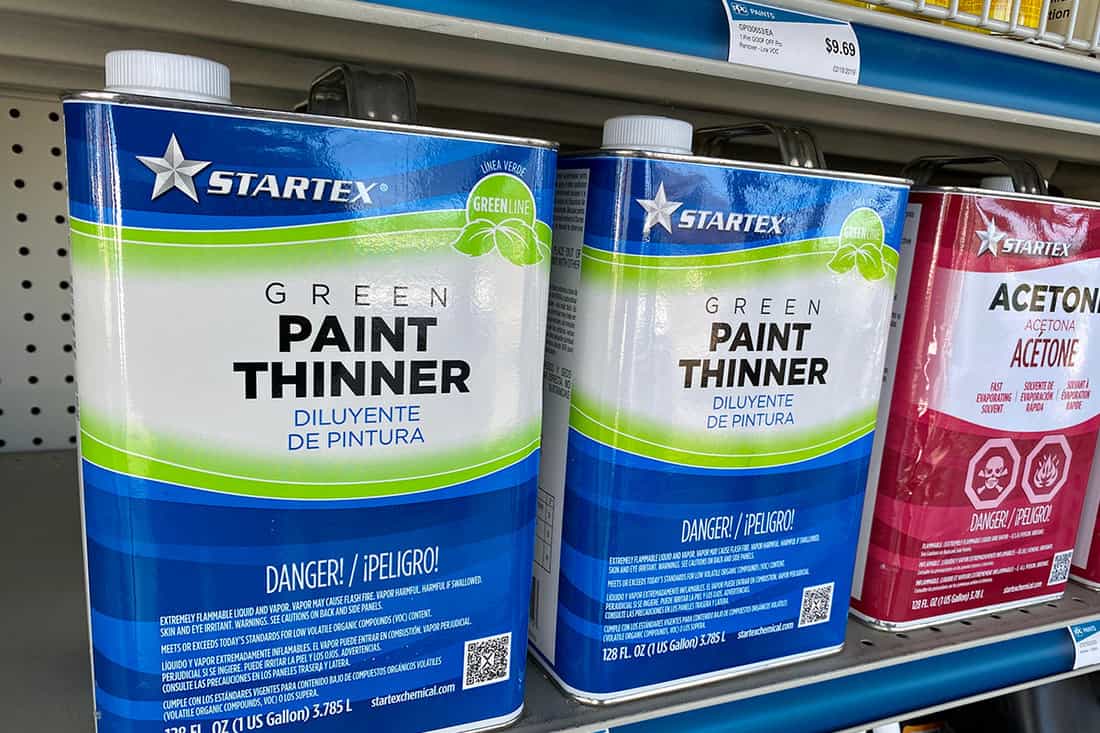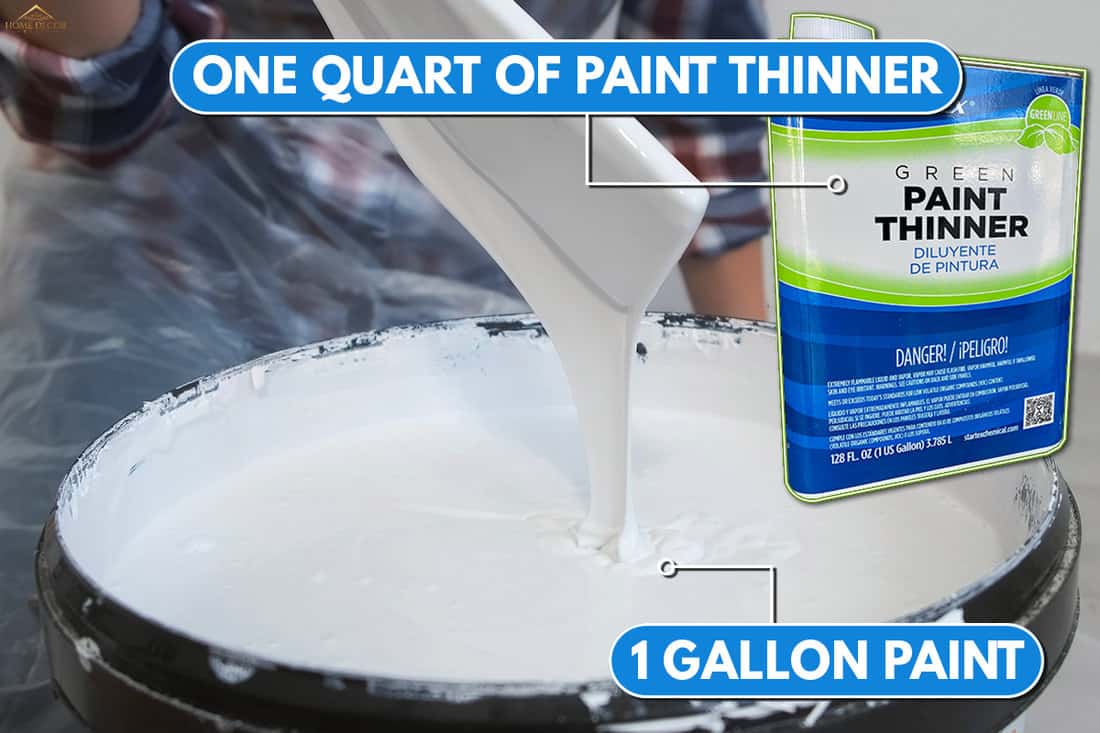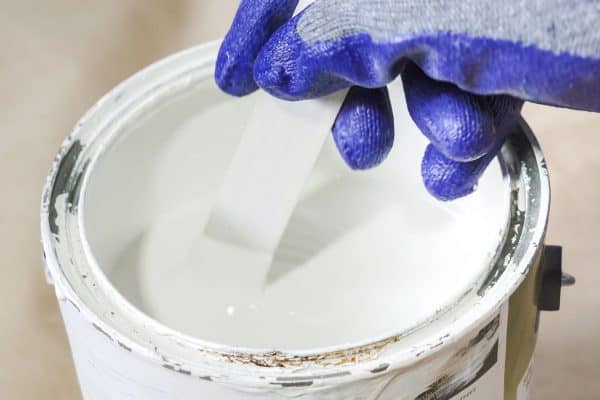Paint thinner is used to bring the viscosity or thickness of paint to a thinner consistency. But how much paint thinner should you use per gallon of paint? Let's take a look below.
A good rule of thumb is a 3:1 or 4:1 ratio of paint to paint thinner. This means that for every gallon of paint, you should add a quart of paint thinner.
This can vary depending on the type of paint and how thick it is, so start with a smaller amount checking the consistency and adding more as necessary.
With paint thinner less is more, so always add a small amount at a time until the desired consistency is reached.
To help you out, we will walk you through adding paint thinner to a gallon of paint. In addition, we will answer other frequently asked questions about paint thinner, so read on!
How Much Paint Thinner Should I Use For A Gallon Of Paint?
A paint thinner can be used to clean up after a project, and thin paint before it is applied. But why would you need to thin out the paint? Paint thinning is necessary to help ensure that the paint will spread evenly on certain surfaces and dry properly.

For example, it's common to use a paint sprayer to apply paint. Paint that isn't thinned out enough won't spray evenly, leaving lumps and streaks.
The difficult part is knowing how much paint thinner you should use, as too much or too little could have a negative effect on the finished product.
When adding a paint thinner to a gallon of paint, it's recommended to start with a 3:1 or 4:1 ratio. This means adding one quart of paint thinner for every gallon of paint.

However, starting with a smaller amount is best, testing and adjusting as necessary. You can always add more paint thinner if the paint isn't thinning out enough, but you can't take it back once it's been added.
Once you have added the paint thinner, use a stir stick to mix it up for a few minutes, checking the consistency regularly.
If it's still too thick, add more paint thinner in small increments until you reach the desired consistency. Once the paint is the right texture, you can start painting!
Using too much paint thinner can change the pigment and finish of the paint, resulting in an uneven or poor-quality finish.
It's important to follow the manufacturer's instructions for adding a paint thinner and always use the correct ratio to ensure you get the best results.
How Do I Know What Paint Thinner To Use?
Not all paint thinners are created equal, and the type you use will depend on your paint. You should refer to the paint manufacturer's instructions or ask a professional for advice.
The ideal paint thinner is one that has been specifically formulated to work with the type of paint you are using, as this will ensure maximum efficiency and performance.
For example, paint thinner that works for oil-based paints won't necessarily work for latex-based paints. It's important to select the right one for the job if you want your paint job to look its best.
Also, you need to ensure the paint you are using is right for your application. For spray painting, you will need to use thinner paint than for brush painting. You also will need more paint thinner, or the paint can clog the spray nozzle.
It's also a good idea to check that the paint thinner is safe for use on any surfaces you will be painting, such as walls and furniture, as some may not be suitable.
What Is The Best Way To Test Paint With Paint Thinner?
We may include affiliate links and curated AI content to highlight top design styles.

Once you have done an excellent job mixing the paint, it's a good idea to test it before applying it. This will give you an idea of what the finished product will look like and help you adjust accordingly if needed.
Do two sample coats on the same surface you plan to paint. Once you have applied the coats, check the texture and finish to see if everything looks good.
If the paint seems too thick or doesn't cover the surface evenly, you may need to add more paint thinner.
In addition, if the paint is running, streaking, or dripping, it is likely that it hasn't been thinned out enough. To fix this problem, add a bit more paint thinner and mix thoroughly before trying again.
It's important to remember that the surface you are testing on should be as close to the final project as possible. This will give you an accurate reflection of the finished product and allow you to make any necessary adjustments.
What Kind Of Paint Needs Paint Thinners?
Typically, oil-based paints and varnishes require paint thinners to achieve the desired consistency. Latex-based paints, however, don't typically need a paint thinner as they are already liquid enough for use without any extra help.
However, if your latex-based paint is too thick or won't cover the surface evenly, you can add a small amount of paint thinner to adjust the consistency. This will help ensure that the paint covers the surface more evenly and give you a better-looking finish.
Make sure that the paint thinner can be used with your specific type of paint before adding it in.
How Do You Clean Paint Brushes With Paint Thinner?

Once you have completed painting, it's time to clean up. Cleaning your paintbrush is a simple process, but it needs to be done properly in order for the brush to remain in good condition and last longer.
- To do this, first place some paint thinner in a container that is big enough for the entire brush head [or, if you're using a roller, the whole roller].
- Then, dip your brush in and out of the container for a few minutes. This will help to loosen up any paint that is still on the brush.
- Once all of the remaining paint has been removed, take some clean paper newspaper and wipe off the excess paint thinner. If you have a spinner brush cleaner, then use that to remove the rest of the paint thinner.
- Next, repeat the steps using two more containers with paint thinner and water. This will help to get rid of any remaining residue from the brush before it dries.
- Finally, store the brush in a dry place, free from moisture, and make sure that you clean your brushes thoroughly after each use.
When finished, put the solvents from all three containers into one and seal it. Dispose of the solvents according to federal, state, and local regulations.
That way, you can be sure that your paint thinner is being used responsibly, and you can keep doing great painting jobs without worrying about any environmental issues.
Can Paint Thinner Be Harmful?
Paint thinner has a number of possible risks, depending on how it is used. If you use paint thinner for something other than its intended purpose, these risks can increase significantly.
For example, inhaling the fumes from paint thinner can be especially dangerous and cause headaches, nausea, dizziness, and breathing problems. Additionally, if it comes in contact with the skin or eyes, it can cause irritation and even chemical burns.
Therefore, it's important to always use paint thinner in a well-ventilated area and avoid inhaling its fumes.
Additionally, you should always wear gloves and safety goggles when working with paint thinner. If you do get any on your skin or in your eyes, be sure to flush them immediately with cool water.
Taking the necessary precautions and using paint thinner responsibly ensures that it remains a safe and effective tool in your painting projects.
How Long Does Paint Thinner Last?

When unopened, paint thinner can last up to 2 years or longer if stored in a cool, dry place. Once the container has been opened, paint thinner will lose its quality over time.
It's best to use paint thinner within a few months of opening and discard any that has been open for longer than this.
This will ensure that you're using the freshest, most effective product and getting the best results from your painting project.
When storing paint thinner, ensure it's out of reach of children and pets, as it can be dangerous if ingested. Check that the lids of the containers are securely fastened, as this will help to prevent any accidents.
Following these simple tips ensures that your paint thinner lasts as long as possible and remains a useful tool in your painting projects.
Read more: Does Paint Thinner Expire? [How Long Does It Last]
Final Thoughts
Overall, paint thinner can be a helpful solvent for your painting projects. By following the guidelines above, you can make sure that it is used safely and responsibly.
Made it to the end? Here are other articles you might find helpful:
7 Paint Thinner Types And Brands [And What They're Good For]



